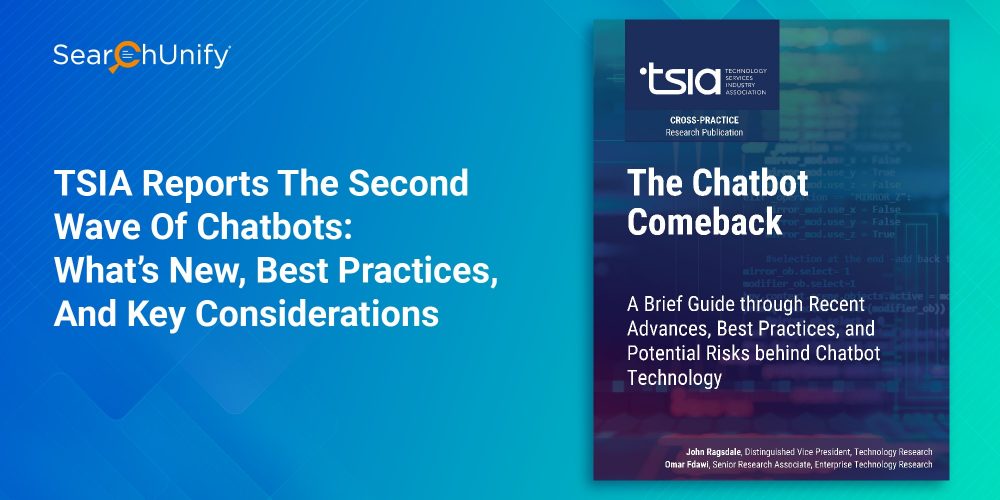

Chatbots are not new. They first appeared in the 2000s and got a lot of attention from business owners due to the wide gamut of benefits they offered. Long story short, they promised to help businesses scale seamlessly & reduce expenditure.
Unfortunately, things didn’t really pan out the way business leaders were hoping they would. In fact, there were more stories about blunders and failures than there were of success. So, chatbots just didn’t fail to deliver expected results, they failed miserably.
But that’s all in the past now. After a lot of hard work, it seems like we finally have the bots that businesses and their customers always dreamt of. These enhanced bots not only overcome their predecessors’ flaws but also try to learn and improve with every interaction.
So it doesn’t come as a surprise that they are gaining a lot of momentum again. Even TSIA has published a dedicated report on what’s new, how they are set to turn the tables, and some recommendations to make the most out of them.
Why First-Gen Chatbots Collapsed Like a House of Cards
The biggest reason that led to the downfall of first-gen bots was their rule-based approach.
To respond to a query, the bot had to be programmed for it. Once that had been taken care of, language presented the next challenge. Different people ask the same question in different ways. Here again, the bot would crumble and resort to its fallback message.
If that wasn’t enough, some of the bots weren’t even capable of passing the baton to a human if need be. This would further add fuel to the fire of an already distressed customer or prospect. Goes without saying that such negative experiences were not acceptable.
The New Capabilities
Thanks to recent developments in AI and machine learning and their following integration with chatbots, all the rough edges have been ironed out. They have not only made the bots more effective but also added a slew of capabilities that elevate the whole experience.
The interactions are a lot more human-like. On top of that, the bots have become adept in processing human language for better extraction of intent and entity from conversations. TSIA has pointed out a couple of enhancements that make all of that possible. This includes:
1. Semantic Processing
This is what drives intent and entity extraction from utterances. Let me explain with an example. With the help of natural language processing (NLP), the chatbot is able to identify that noon, 12 p.m, and 12 o’clock all mean the same thing. It finally gives bots the ability to understand the user which further improves the quality of the interaction.
2. Machine Learning
A potent application of AI, machine learning enables systems to proactively observe and learn over a period of time, thus eliminating the need for manual programming or training. This helps to keep the maintenance to a bare minimum while continuing to improve the experience for more positive and successful interactions.
3. Conversational Experience
People tend to forget some key information while interacting with chatbots. In such cases, the bot would promptly request for the needed information for better comprehension of the need and hence provide a fitting response. Additionally, the bot is empowered to tailor the responses to fall in line with the user’s query. All these help to substantially improve the flow of dialogue.
4. Unified Search
Unified search creates an index of all your organizational data across platforms for quick access. And when chatbots are amalgamated with these state of the art engines, the result is nothing short of breathtaking. It allows the bot to scour your entire database to accurately answer a user. This further reduces the need for manual effort as the bot can understand the query, find relevant answers, and present them in the way the user expects them.
5. Omni-Device
Organizations also need to ensure that their chatbot works flawlessly on every device like PC, mobile, or SMS. A majority of customers, prospects, and employees are millennials or gen Z, and these tech-savvy people interact the most with chatbots via different devices. With AI-based chatbots, you can provide a uniform experience throughout and keep users happy.
Ready to Experience the Transformation of Chatbots?
Now we know that AI-fueled chatbots are going to transform customer interactions. Thus, for your business to grow it becomes imperative to invest in them.
In this aspect, SearchUnify’s Virtual Assistant (SUVA) is at your service. With its GenAI capabilities, it is all your business needs to set on the trajectory to success.
Curious to know How?
Click here to learn more!